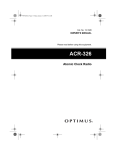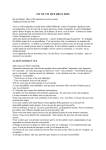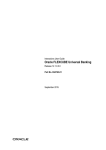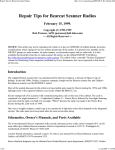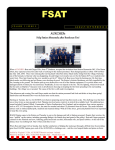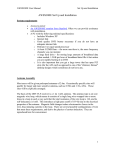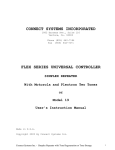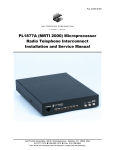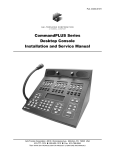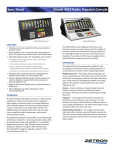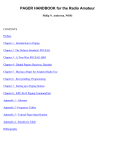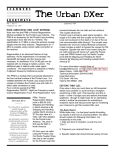Download Dec #2 - nydxa
Transcript
S C A N N E R S SHORTWAVE The U rb a n DX ’e r Vol. 1 No. 13 December 20, 1997 THE SOU NDS OF SHORTW AV E If you haven’t been an SWL listener for more than 10 years than many of the historic and nostalgic stations you often read about are only known by name. Despite my 30+ years in the radio hobby, there are those stations I never had a chance to hear. RADIO CAROLINE was one of them, simply because they’re on long wave and reception on this side of the pond is pretty limited. Check out this uniques web site where you can turn back the hands of time and listen to program segments from many of short waves golden years! http://voa.his.com/sos/ W NBC-TV / U PN9 Charlie, KB2UVV passes along this update for you news listeners. 450.5375 mhz was used by "Chopper 4" to communicate w/ L-Control during the Macy's Thanksgiving Day Parade. Call Sign I.D. (In C.W.) is KJP-867. Chopper was told to move from its normal Freq. (450.8875) by L- Control at 8:50 A.M. just 10 minutes before the start of the Broadcast. Chopper was communicating with various "L" Units through out the Broadcast, and all of his communications were in the Clear. I even heard The Urban DX’er "Chopper 4" speaking w/ News 4 News Desk The Urban DX’er is published on 161.670 mhz monthly through the concerning a report that cooperative efforts of Bob was called in concerning Kozlarek, WA2SQQ and Charlie Hargrove, N2NOV a "Bodega" on 9 th St. that suppossedly had Any information contained is "Live Turkeys" hanging considered public and can be Upside-Down from the copied, distributed or awning out in front of otherwise electronically the Bodega. News Desk distributed provided that proper credit is given.. wanted Chopper 4 to go take a look at this to see Contributions of information if it was in fact correct, for future issues is always but Chopper was still welcomed and greatly doing Overheads and appreciated. Please send your "Bumper Shots" for the E mail to [email protected].. Established 1984 telecast and could not break away. Anyway this did in fact turn out to be a "Bogus" Tip, or if I may Quote the News Desk, it was a "Fowl Call" !!! Anyway, this is the first time that I have heard 450.5375 MHZ. used by Chopper 4 or even by WNBC . I have been monitoring 450.4875 mhz this afternoon, and have confirmed that it is being used By UPN-9 (WWOR-TV) as a News Desk Assignments frequency. I heard it a few times this afternoon while I was watching the Jets football game, and finally heard one of the people call for UPN-9 Desk, so this one is also confirmed. METRO FIRE REASSIG NMENT Just after the last newsletter went out I started hearing, or should I say not hearing, traffic on the 463.900 Metro Fire frequency. This is a group of scanner enthusiasts that monitor the NY metro areas fire frequencies and broadcast them via pagers and their repeater. There was talk overheard that they were reassigning frequencies. I put out a request to all of you and got two rapid responses from John, KB2SGJ and N2OAD. Between both of their responses here’s what we now know and have confirmed about Metro Fire. My thanks to all who responded! Metro Fire Ch # 1 463.650 Ch # 2 452.175 Ch # 3 462.625 Ch # 4 463.900 PL 146.2 PL 114.8 PL 156.7 PL 203.5 ** ** Input is at 468.9125 Red Cross ( Bergen County ) Ch # 1 464.400 / 469.400 DPL 223 Ch # 2 463.425 / 468.425 DPL 223 Ch # 3 462.625 / 467.625 PL 156.7 Joe, N2OAD wrote: I belong to a rehab unit ( Box 54 type ) now available for South Bergen County cities based out of Moonachie where I live. P.S. I don't live in Hasbrouck Heights. This is a new joint venture between the Red Cross and the Moonachie Fire P20 December 1997 The Urban DX’ er Dept. So I'm sure these are the correct frequencies. I don't know about the new freq you are talking about, but I can find out and let you know. Most of the activity is on Red Cross Chan 2. The unit is ERV1. You can here the dispatch out of the Moonachie FD freq 154.16. I monitored the Macy's freq you talked about 464.175. It was correct and I found the PL was 203.5. I went to both Hoboken and into the city to see the floats and balloons. I got some pictures including the police mobile unit by Central Park. As soon as I get the pictures developed, I'll see if I can get them scanned and E-mail them to you. METRO FIR E PHOTOG R APHE R S Ch #1 462.650 Ch #2 462.925 Ch #3 471.4875 PL 85.4 PL 100.0 PL 100.0 “DEALE R ” ARRESTED The Miami Herald reports that Metro-Dade County Florida Police recently arrested a man and charged him with dealing in stolen property. The property in question is the highly secret digital coding to the encrypted police radio system. Prosecutors allege that the man programmed radios with Metro-Dade frequencies and sold them to anyone willing to pay his asking price. Detective Steve White, a member of Metro-Dade's Economic Crime Bureau and High-Tech Crimes Squad says that his department does not even know how he got hold of the propriority program software to do this. But there is one clue. The Herald story says that the FBI has been investigating the same person for computer fraud and copyright infringement since December. This, after agents raided his home and business and seized a stash of radios, computer equipment and diskettes. Metro-Dade police began their inquiry several months ago when they took a statement from a citizen who said he bought two modified radios for $1,300. He turned over the two radios to police and was not charged with any crime. The radio cloner may not be so lucky. If convicted he could spend up to fifteen years behind prison bars. SALEM COU NTY NJ Just saw this on the net... The Salem County Department of Emergency Services will be implementing its new trunked system soon; it should be up and running in early (January) 1998. Most of the county's fire departments are all looking at new radios. The no frills mobile unit form motorola cost about $4800. The frequencies will be UHF, around 504 mhz. I should get more info on the system tonight; if I do I'll send it here. FIR E NEW S PAG E This is a pretty strange site. It contains a collection of audio files from sirens to actual fire calls. It’s worth checking out, though it is among the stranger ones I’ve seen. http://pages.prodigy.com/Guilderland/sounds.html http://members.aol.com/NMETSY/fire.html PLECTRON HISTORY In the 1960s and 1970s, thousands of firemen and ambulance squad members came to rely on their crystal controlled, transistor Plectron and Motorola desktop monitor receivers. They have now been replaced by battery operated portable pagers, and the desktop models are often available at hamfests in the $5 - $25 range. Since many are in rough condition and need repair, a hamfest special is better suited for hobbyists who like to fix their own radios. Plectron and Motorola crystal controlled receivers are excellent for dedicated monitoring of local frequencies -- a task for which you wouldn't want to tie up your 400 channel programmable scanner. They are desktop models which can be powered from 117VAC or 12VDC with the proper mobile cord. The audio quality of a Plectron P1, Plectron 700 series, and Motorola Alert Monitor is far better than any consumer grade scanner and the sensitivity, image rejection, and intermod immunity is outstanding when aligned properly. Models and Frequency Coverage The Plectron and Motorola Alert monitors are single band receivers: VHF-low, VHF-high, or UHF. No single Plectron or Motorola Alert monitor can cover the entire 30-50 MHz band, so there were versions optimized for each portion of the VHF-low band. There were different versions to cover low and high "splits" in the VHF-high band, too. For example, low P20 December 1997 band R8000s come in 30 - 35, 35 - 39, 39 - 49, and 49 - 54 MHz versions. There are two VHF high band versions of the R8000: 148 - 158 and 158 175 MHz. VHF-low band Motorola Alert monitors come in two splits: 30 - 42 and 42 - 54 MHz. Although UHF versions of the 700 series were made, they are somewhat rare and coverage is limited to 470 MHz and below. The Urban DX’ er various colors. The R8000s use the same MC3357 IF/detector/squelch IC used in crystal scanners, but their crystals are not interchangeable with ordinary scanners. R8000s were made in the Chief (tone decoder & carrier squelch) and Patrol (carrier squelch only) models: Band (MHz) Chief Patrol ___________________________ 30-54 R8190 R8150 148-174 R8200 R8160 Plectron made several models with dozens of different options. Both the original P1 and later 700 series are suitable for restoration, although I prefer the newer 700 models. The 8000 series were even newer and very desirable, but they are difficult to find at hamfests. The Plectron 500 "economy" series is less desirable. Table 3. Plectron 8000 models The Plectron FM Receiver/Recorder is a collector's item. It is essentially a 700 series Chief receiver with a built in cassette tape recorder. The recorder is carrier activated and can tape transmissions while the receiver is unattended. A connector on the rear panel allows for all kinds of remote control possibilities. The P1 series have black cabinets with a blue-green and silver color scheme used on the front panel. They were made in the Chief (tone decoder & carrier squelch), Patrol (carrier squelch only), and Sentry (tone only) models. The Sentry models lack a carrier squelch and therefore are of little use to hobbyists except for scavenging parts. Model number and frequency information appears on a gummed label on the rear panel: I use two Plectron P1s and four R700s in my living room, seven R700s down the basement, and several Plectrons and Alert Monitors stored in reserve. The basement Plectrons are turned on automatically when someone walks downstairs. Power to them is controlled by a modified Radio Shack Safe House infrared motion detector, originally sold as an intrusion alarm. Band (MHz) Chief Patrol Sentry ____________________________________ 25-54 R19 R15 R17 148-174 R20 R16 R18 450-470 R23 R21 R22 Table 1. Plectron P1 models The R700 series have black cabinets with brown front panels and are slightly smaller than the P1 receivers. R700s were made in the Chief (tone decoder & carrier squelch) and Patrol (carrier squelch only) models: Band (MHz) Chief Patrol ___________________________ 25-54 R719 R715 148-174 R720 R716 450-470 R723 R721 Table 2. Plectron 700 models The R8000 series are much smaller than the P1 and R700 and are housed in metal cabinets of When a rescue squad member from Missouri advertised a number of Plectrons on USENET, I bought them -- all 20+ of them. I cleaned, fixed, and restored each one. After recrystalling them on local frequencies, I distributed them to members of my scanner club who were glad to get them. Both brands of receiver require special crystals. I sometimes use Radio Shack's generic 3rd overtone scanner crystals in the Plectrons but they oscillate on frequencies far away from their marked frequencies. That's because the Plectron oscillator is designed to be used with a crystal which oscillates on its fundamental, not overtone, frequency. AC power cords for both types of receivers use unique connectors and are scarce. You can buy them new but it's much cheaper to drill a hole on the rear panel and attach a permanent a power cord. Make sure you use a grommet in the hole to prevent the metal chassis from chafing the line cord. Many Plectrons and Alert Monitors were equipped P20 December 1997 with an internal NiCd battery pack, intended to power the receiver if the AC power fails. It's unusual to find a used monitor receiver with the NiCd pack still capable of holding a charge. More often, the batteries have died and the series charging resistor has overheated and burned. Be sure to remove the dead batteries as they often leak. If you find the squelch on your Plectron 700 series receiver has too much hysteresis, replace R96, a 180K resistor, with a 560K resistor. On the P1, the resistor is designated R81. Minimum Volume Setting Both Plectron and Motorola Alert monitor receivers are designed purposely to have a minimum volume setting which is still audible. The intent was to prevent firemen from turning the volume down completely, forgetting it was down, then missing an important call. This "feature" was usually implemented by having a fixed value resistor in series between one end of the volume control and ground. In the R15X5, R14X5, R15X5, and R16X5, a 47 ohm resistor, designated R624, was inserted in series with the violet wire leading from the volume control. You could decrease the lowest volume setting by decreasing the value of this fixed resistor. Alternatively, you could replace the resistor with a jumper wire to completely silence the receiver at minimum setting of the volume control. Tone Alert Feature I have not used the Plectron tone alerting features so I cannot address that except to say that the special coils and capacitors for the dual tone decoders vary depending on the tone frequencies and are somewhat difficult to obtain. Repair and Replacement Parts Repair service and replacement parts for the Plectron P1 and R700 models is offered by: Weber Electronics PO Box 212 5138 Laurel Ln. Broad Run, VA 20137 telephone (540) 347-7760 You can also obtain Plectron repairs and parts from: Northeast Communications The Urban DX’ er 4 Oak Ridge Rd Newfoundland NJ 07435 201-697-8804 Alert Monitor parts are available from Motorola. Phone (800)972-3226. Plectron SM-series Scanning Receivers Plectron also sold an SM series of scanners, manufactured in Japan by the same folks who made Craig (division of Pioneer) scanners. The SM series are consumer-grade models and are included in this article for the sake of completeness. They are crystal controlled radios and feature priority scan and a separate trimmer capacitor for each channel to net the crystals on frequency. Band Frequency Limits ___________________________ VHF-low 30 - 50 VHF-high 150 - 174 UHF 450 - 470 MHz Table 4. Plectron SM Model Band Limits Model UHF VHF-high VHF-low _________________________________ SM-301 X X X SM-302 X X SM-303 X X SM-304 X X Table 5. Plectron SM Models The crystals used in the SM series are quite different from the crystals used in the conventional single channel Plectron monitors. Here are the crystal formulas: VHF low band: crystal 3rd overtone freq = receive freq + 10.7 MHz VHF high band: crystal 3rd overtone freq = (receive freq - 10.7 MHz)/3 UHF band: crystal 3rd overtone freq = (receive freq - 10.7 MHz) / 10 P20 December 1997 Other crystal specifications for the SM series are: CR 25/U holder 3rd overtone 20 pF load capacitance parallel resonant max series resistance 40 ohm max drive 2 mW SCANNE R SE R V ICING Many of us have some of our first scanners sitting there collecting dust. Most manufacturers will only provide service for a limited time after models go out of production. While net surfing I came upon some info from “author unknown.”If I had to guess, I would say it was Bob Parnass as the style and quality is representative of his work. Anyway, here’s the doctor that can fix your vintage scanner! G & G Communications (telephone (716)768-8151) is a family owned company which repairs scanners and stocks parts for several older models, especially Electra/Bearcat and Regency brands, but they don't sell manuals or schematics. They are located at 9247 Glenwood Drive, LeRoy, NY 14482. (http://www.iinc.com/ggcomm/ or email [email protected] or [email protected]) The Urban DX’ er board. The front panel assembly must be removed from the chassis by removing 4 flat head screws, 2 on each side. You need not disconnect all the wiring harnesses, though you might have to unplug one so it won't get in the way of a hot soldering iron. Unsolder the bare ground wire soldered to a large shield on the back of the front panel, located near the back of the squelch control. Two ground braids must be temporarily disconnected by removing the screws which fasten them to the chassis. After removing the volume and squelch knobs, you must remove 8 small screws which fasten the plastic front panel to the diplay board. The old EL panel is fastened by a bead of glue and two foil type leads soldered to the display board. It's easier to cut the two leads from the old EL panel before un-soldering. A sharp knife should be used cut away the glue. The old EL panel can then be slid gently out from behind the LCD display. The new EL panel can be installed by reversing the process, though I found that it is not necessary to glue the new panel. The two foil leads must be soldered using a minimum of heat. Reassemble the pieces in reverse order of disassembly. RADIO SHACK / G R E F IX ES TO COMMON PROBLEMS GRE-BUILT BASE MODELS: DIM BACKLIGHT The backlight in many base models, including the PRO-2022, PRO-2004, and PRO-2005/6 is implemented by an electroluminescent panel, which grows dim with use. GRE-Built Portables: Worn Out Keypads The keypad on late model GRE-made Radio Shack portables, e.g., PRO-39 and PRO-43, can become unreliable after prolonged use. The best repair is to replace the rubber keypad instead of trying to restore contacts using chemicals. A replacement rubber keypad may be ordered inexpensively through Tandy National Parts or your local Radio Shack Store. The EL panel used in the PRO-2005 and PRO-2006 is designated EL-501, and is identified by Radio Shack part #10800050. A new EL panel can be ordered through your Tandy National parts (see above) or local Radio Shack store and sent to your home. Radio Shack no longer sells replacement EL panels for the PRO-2004. PRO-43: Loss of Audio Early PRO-43s were built with a 200 mW speaker (mfr's part #EAS-3P123A). The voice coils in some of these speakers have opened, resulting in lack of audio output, though audio is still available from the earphone jack. A more capable 500 mW speaker is available through Tandy as replacement (EAS-3P127). Replacing the backlight is an operation which requires care and patience. Purchase a service manual, and study the exploded parts diagrams as you read the following steps. PRO-43: Freezup If you attempt to lock out all 20 channels in a memory bank, then scan only that bank, your PRO-43 will freeze up and be placed into a catatonic state. Use the procedure documented in the PRO-43 user manual to fully reset the scanner. This will "break the trance," but all the Top and bottom cabinet pieces must be removed, then the speaker unplugged from the main P20 December 1997 The Urban DX’ er memory channels will be cleared. worldwide leader in commercial radio. PRO-2004: Dead If your PRO-2004 is completely dead, check R235, a 1 ohm, 1 watt resistor mounted vertically on the main board. The station first went on the air in 1904 as "Radio PH" owned by the De Forest Wireless Telegraph Company. The station pioneered transpacific radio communication with foreign stations and with ships at sea. The transmitter was located in the old Palace Hotel, but the hotel and the station were both destroyed in the 1906 earthquake and fire. The station was revived and sold to the Marconi company, and in 1912 its transmitter was relocated to Bolinas and its receiver to Tomales Bay. Marconi himself chose the site, mostly because it was free of interference from electrical storms and sunspots. SHORTW AV E G U IDE ONLINE Http://members.aol.com/Unix3133t/shortwave.html OLDEST MARITIME RADIO STATION ON COAST CLOSES DOW N By Carl Nolte S.F. Chronicle Writer June 30, 1997 was the last day for radio KPH, the oldest maritime radio station on the West Coast, which has operated for more than 80 years in West Marin. It was done in by advancing technology and a shrinking market for its services. The station is not well known to the general public, but in its day was vital to sending and receiving messages to ships at sea - everything from routine business instructions to emergencies. It is also among the oldest commercial enterprises in the Bay Area, dating back to the earliest days of wireless transmission. KPH communicated with ships at sea by using high-speed Morse Code and Sitor, a form of radio teletype communications. However, according to station manager Jack Martini, most maritime communications now use satellite technology. "There's not enough business left for more than one West Coast operation," he said. "It's the end of an era.". The station, which is now owned by MCI International, is being acquired and shut down by Globe Wireless in Half Moon Bay, its principal competitor in the marine radio business. Globe, which operates KFS marine radio, takes over the KPH call sign and frequency today. The old station's transmitting facilities on the Bolinas Mesa and its receiver and equipment on the Point Reyes Peninsula are now closed. The land, about 100 acres which houses transmitting and receiving equipment and fields of huge antennas, will be turned over to the National Park Service as part of the Point Reyes National Seashore. The station dates back to the earliest days , of the electronics industry and its history is full of the great names of radio, Guglielmo Marconi, the inventor of radio; Lee De Forest, a San Franciscan who invented the vacuum tube; and the Radio Corporation of America (RCA), which was a In 1920, Westinghouse, General Electric and AT&T formed RCA. The receiver was moved from the Tomales Bay site to a new location near Abbott's Lagoon overlooking the Pacific on the Point Reyes Peninsula. World War 11 brought a flood of business, but the station's busiest time was during the war in Vietnam, when, Martini said, there were as many as 1,000 radio messages a day sent to ships at sea. The radio communications enabled land-based managers to keep track of ships all over the world expediting changes in sailing orders, personnel decisions, cargo decisions, and forwarding detailed instructions to the ship's master on every facet of the operations. However, advances in technology and changes in the shipping industry (fewer ships staffed by smaller crews) left KFS with a smaller and smaller market. "Now," said Martini, "we are lucky to get 100 messages a day." The corporate ownership also changed. General Electric acquired RCA in 1986 and sold the marine radio business to MCI in 1988. Globe Wireless, with closing the Marin station on July 1, is optimistic about the market, said Dino Martin, Globe's station manager. "This will be the 13th station we have acquired," he said. "We are putting in e-mail and telex and will have the Internet available to ships at sea (from the Half Moon Bay station)," he said. But to Martini, who has been with the marine radio station at Point Reyes for 36 years, it's a ifferent story. "It's a sad day," he said. Courtesy of the San Francisco Chronicle P20 December 1997 The Urban DX’ er W W V B U PDATE If you recently purchased one of the “Atomic Clocks” from Radio Shack and are experiencing sporadic reception, be assured that the folks at NBS are listening. Over the next few weeks WWVB Service Interruptions can be expected. During this time testing of new antenna networks and transmitters will be taking place in preparation for a power increase to 40 kW. The goal of this project is to achieve higher output power for service commencing on December 25, 1997. The projected power increase will be from the current 13 kW to 40 kW. This will substantially increase both daytime and night time coverage at 60 khz. To follow details of the work and keep track of scheduled outages, click on these links for WWVB status. http://www.boulder.nist.gov/timefreq/wwvstatus.htm http://www.bldrdoc.gov/timefreq/vboutage.htm V LF PLACES OF INTEREST So while we’re on the topic of VLF (Very Low Frequency), check out this page brought to you by members of the Longwave Club of America. In the Longwave spectrum, you may encounter everything WWVB Antenna Site from utility beacons to micro-power license-free (Part 15) stations testing advanced modulation modes. Natural radio signals, such as whistlers and other fascinating phenomena, open windows into geophysics and solar physics as well. There's no limit of challenges. http://users.aol.com/lwcanews/index.html A comprehensive list of LOWFER and MEDFER beacon stations found at http://users.aol.com/part15/lfmfbcns.htm Lowfer stations operate from 170-190 kHz. They are permitted to run up to 1 watt into limited length antennas. Despite these limitations I’ve copied them from as far as South Jersey on some cold winter nights. Very narrow CW filters or DSP audio filters really increase your chances of logging these stations. “MEDFER”Beacon stations are also located in the area just above the AM broadcast band from 1605WWVB Insulator Repair P20 December 1997 1700 khz. Jack Sippel (KUØKU) has prepared two files that should be of considerable interest to LF aerobeacon enthusiasts, and they are available to you in the universal .xls spreadsheet format at http://www.mindspring.com/~longwave/aero_db.htm An on line search engine for Canadian NDB’s (Non Directional Beacons) is available at http://ftp.bruderhof.com/ka2qpg/ If you’re new to the low frequency scene youmay want to check out this page which has many useful links to useful utilities used to DX this portion of the RF spectrum. The Urban DX’ er 2. OFF AIR PERIODS 221000Z SEP 97 THROUGH 300300Z SEP 97: A. http://www.navcen.uscg.mil/ This site also provides in depth info on other navigation methods that include GPS, DGPS, LORAN and CGSIC. W HO IS THIS G U Y ? Can you identify this person? He’s been in the news and you’ve been following his daily agenda? The answer will appear on the last page of the newsletter! http://users.aol.com/us66soft/lfutil.htm Among the links, US and Canadian links to Airport and NDB sites as well as links to the National Bureau of Standards and companies that serve this aspect of the VLF hobby. OMEGA SE R V ICE TERMINATES The coast guard terminated its involvement in the Worldwide Omega Radionavigation System on September 30, 1997. This included closure of the two stations located in the U.S. (Lamoure, ND and Haiku, HI) and termination of the existing bilateral agreements with the six partner nations (Argentina, Australia, France, Japan, Liberia, and Norway). The Omega navigation system primarily serves aviation and weather users. The Department of Transportation recently completed its review of the Omega navigation requirements and notified the U.S. Coast Guard that most users will complete their conversion to Global Positioning System technology by September 1997. Officially the last update was sent as g follows.. P 011416Z OCT 97 FM COGARD NAVCEN ALEXANDRIA VA//NIS// TIME TO CHECK OU T It’s time you check out the Time Service Department U.S. Naval Observatory. The Time Service Department, U.S. Naval Observatory is the official source of time used in the United States. http://tycho.usno.navy.mil/ http://tycho.usno.navy.mil/what.html http://www.npl.co.uk/cgi-bin/countdown.pl http://www.npl.co.uk/npl/cetm/taf/ RADIO SHACK SE R V ICE MANU ALS Despite promises and rumors that Radio Shack would resume the sale of service manuals for scanners that can receive 800 MHz, this hasn’t happened. At least one page will be posted soon to urge a boycot of all Tandy owned companies. These include Radio Shack, Computer City and Tech America. Readers are urged to contact Tandy management at the following e mail addresses. SUBJ: OMEGA STATUS AS OF 01 OCT 97 1. THE OMEGA NAVIGATION SYSTEM TERMINATED AND ALL STATIONS CEASED OMEGA TRANSMISSIONS AT 0300Z 30 SEPTEMBER 1997 IN ACCORDANCE WITH NAVCEN OPERATIONS ORDER DATED 141026Z AUG 97. [email protected] [email protected] Voice your concern and your support. Since many of Radio Shacks scanners are made by Uniden, we suggest supporting companies who support their customers. Several internal memos obtained by The Urban DX’er direct store managers to “promise P20 December 1997 The Urban DX’ er nothing”with regard to a resumption of service manual sales. And if you think that their company image problem is limited to scanners, think again. On December 2, shock jock Howard Stern did a royal trash job on Radio Shack’s products and sales practices. I listened and couldn’t believe my ears! Estimates have Stern’s morning audience in the US and Canada between 8 and 10 million listeners! Thanks Howard!! the priority channel for that bank. Additional banks can be used as you see fit, designating one additional channel in each bank as a priority channel. Activating the PRIORITY feature will scan these channels every 2 seconds as long as each bank is selected. TRU NK TRACKER TRICKS Today’s mail brought the December issue of MT. Among all the neat articles I found a most enlightening article on the Trunk Tracker. I thought I knew it all! Reading, I discovered a very interesting fact - “Though you can program frequencies into memory in any order, the TurboScan algorythm scans frequencies in ascending frequency order within each selected bank.”Sure enough, I reprogrammed one bank in ascending frequency order and there was a noticeable increase in speed! The city is loaded with airwave "dead zones" that make police radios useless when cops have to make life-or-death calls for help, The Post has learned. The article discloses the fact that the 85 channels/sec spec is with the CTCSS feature turned off. In my best guestimation, CTCSS tone receive probably decreases scan speed by about 50%. “We found that powering on the Trunk Tracker while pressing these keys simultaneously produced interesting results.” ! ! ! ! ! ! ! Manual 2 9: Reset - Erases all channels Scan 2 9: Loads test frequencies into channels 1- 17 Delay 2 9: Displays 000 0F. Can use Hold and limit keys to step through addresses 000 - FFF Data 2 9: Displays “LOAD” CTCSS 2 9: Displays H 162.400. Press ALRT to test alert tone. PRIORITY 2 9: Loads channels 1-300 with frequencies between 144-149.98 in 20 khz increments. TRUNK 2 9: Displays “CT”“Trunk”and scanner beeps. I’ve read the manual twice and I missed the fact that you can designate one priority channel in each bank. I immediately programmed my local PD in channel 1 in Bank “A”, designated as a priority channel. Bank “B”is used for several of the emergency notification groups like Box 54 and Metro Fire. I designated Metro Fire’s channel 1 as COPS R ISK LIV ES IN RADIO ' D EAD ZONES' By Larry Celona "We're supposed to have the biggest and best police department, including the best equipment and one cop can't call another," griped one officer. "It's absurd." Department brass admit there are spots in all five boroughs where police radios can't transmit. They say the system will be overhauled over the next seven months to correct the problem. "A lot of it has to do with environmental factors - this is New York City. There is a lot of congestion, a lot of tall buildings made of steel and concrete," said Capt. Thomas Ryan of the NYPD's Communications Division. The extent of the problem became apparent last week when delegate after delegate at a Patrolmen's Benevolent Association meeting told of cops needed help fast but couldn't contact officers a short distance away over their police radios. Here are just a few cases from one station house, the 115th Precinct in Jackson Heights, Queens: On Oct. 28, two cops injured in a confrontation with an emotionally disturbed man in an apartment building on 34th Road were unable to transmit a "10-13" (officer needs assistance) call - even when they leaned out a window. One of the cops had to leave the building to call from the street. The next day, a cop had trouble radioing for help when an agitated driver got out of hand while he was being given a ticket on the Grand Central Parkway. The same day, two cops involved in a squad-car accident while chasing a purse snatcher were P20 December 1997 unable to call for help, although their radios were not damaged in the crash. They didn't get help until a cop in a passing patrol car saw them. On Oct. 30, cops had trouble calling from inside a building on 95th Street where they were struggling with a man who was beating his mother. Similar problems have been reported throughout the city - in low-lying parts of Washington Heights, in a housing project on Richmond Avenue in Staten Island, and in Crown Heights, Brooklyn. Ryan likened the problems to the trouble civilians have trying to use a cellular phone "and you have to move a few feet either way to be able to pick up a signal and make a call." He said that could seem like an eternity to a cop in a tight situation. Ryan said the NYPD is "enhancing" the system with new equipment to better boost and receive police-radio signals, a process that should be completed by June. It's "a complex issue" because police can't shut down a technical system for a few days, the way a company might while bringing in new computers. "We're trying to build a new system while keeping the old system functioning 24 hours a day, seven days a week," Ryan said. “R ” DOES IT AGAIN! Last month “R”, our anonymous listener from CT, contributed a major portion of the Shopping Mall frequency list. Since that time he’s been very busy stuffing the Urban DX’er Christmas stocking full of frequencies and information. Those of you who frequent the 146.805 net on Tuesday’s are acquainted with his dedication to the scanning hobby. For those of you who aren’t, you’re in for a real treat. Since the last newsletter I’ve received more info than I could possibly use in one newsletter. We’ll include as much as space permits in each issue in a scanning potpourri format. Besides the information mentioned in this section, I’m going to include some SWL loggings that “R” submitted. These have been received and confirmed, not simply copied from another publication. Through the magic of optical scanners and Adobe Acrobat, his actual listings will be The Urban DX’ er included at the conclusion of this newsletter. It’s a novel way of presenting the time he took to document all these catches and it saves me lots of typing! Ny Jets Ht’s F1:457.5875 F2:464.925 F3:464.950 Port Authority 800 System 866.2125, .8125 867.375, .875 868.550, .600, .9125 Nassau County Police (Assigned for Future Use) 123.100 Aviation SAR 484.1125, .3625, .6125, .8625 W PIX -TX MY STERY SOLV ED During last month’s NYC Marathon we all noticed the absence of related radio activity. “R”submitted this response he received from a member of the engineering staff at WPIX... “Thanks for your interest and compliments concerning WPIX's coverage of the New York City Marathon. The coverage this year was severely hampered by the weather. The cameras following the runners for 26 miles are on motorcycles. These motorcycles then send the video and audio through a microwave link to a helicopter hovering above. The helicopter then relays the signal also via microwave frequencies to a receiver atop the Citbank building in Queens. From there it goes via optical fiber back to our studios where it is mixed with the rest of the show. You can imagine how rain, winds, fog, and lightning can affect this process! Yes, this year they got away from the 450 and 455 Mhz. band in favor of a trunked Motorola 900 Mhz. system. As you probably know, these frequencies are almost impossible to monitor because of the changing of channels that accompanies each transmission. While the frequencies used in previous years were considered confidential, they were at least scannible. This year, they were not. Thank you again for your kind words and interest; if you want to check back with me for more information or details, I have enclosed my business card. Sincerely, R.A.”(Name Intentionally Omitted) P20 December 1997 The Urban DX’ er SW L LOG G ING S In addition to the loggings submitted by “R”, here’s a few that Charlie, N2NOV and I came up with. Radio Vietnam 5.940 nightly at 2130 local time (Eastern). English commentary and music. TIME STATION COUNTRY FREQUENCY 0000-0100 0000-0500 0000-0600 0000-0700 0000-1000 0000-2400 0100-0100 0100-0130 0100-0200 0100-0200 0100-1200 0100-1300 0200-0230 0230-0300 0300-0330 0300-1200 0330-0400 0400-0450 0400-0500 0400-0500 0400-0500 0400-0500 0400-0500 0400-0500 0400-0900 0400-2200 0500-0530 0500-0530 0500-0530 0500-0600 0500-0600 0500-0600 0500-0600 0500-0600 R.Japan (Gen.Sce) WWCR-1 Croatian Radio HCJB WEWN WJCR-Worldwide Uni. Chr. Broadc. R.Yugoslavia R.Ukraine Int. R.Ukraine Int. RFPI WWCR-2 R.Yugoslavia BBC World Service BBC World Service WWCR-4 BBC World Service V.of Turkey BBC World Service BBC World Service R.Ukraine Int. V.of America WSHB WYFR Family Radio WMLK BRT International BBC World Service BBC World Service Swiss Radio Int. R.Japan (Gen.Sce) R.Pyongyang V.of America WSHB WYFR Family Radio JAPAN USA CROATIA ECUADOR USA USA UNITED KINGDOM YUGOSLAVIA UKRAINE UKRAINE COSTA RICA USA YUGOSLAVIA UNITED KINGDOM UNITED KINGDOM USA UNITED KINGDOM TURKEY UNITED KINGDOM UNITED KINGDOM UKRAINE USA USA USA USA CYPRUS UNITED KINGDOM UNITED KINGDOM SWITZERLAND JAPAN KOREA (D.P.R.) USA USA USA 6155,6180 3215 5895,7370 21455 5825 7490,13595 6200 6195,7115 5905,5940,6020,6050,6080, 7150,7205,7290,7420,9560 7385,7585 5935 6100,7130 7325 6195,9410 2390 6195,9410 7300,9685,17705 3955,5875,6180 6195,9410 6020,7150,7205,11905 7170 7535 9985 9465 6159 3955,6180,6195, 9410,12095 5840,6165 6150 11740,13790 11825,15205 7535 9985,11580 A PIECE OF A PU ZZLE By Bob Kozlarek, WA2SQQ Like most of us, we all had an “Elmer,”a person who was responsible for motivating us into the radio hobby. For me that was Art Moore, W2MJD. Art lived in N Arlington, NJ and was chief engineer for WMCA. He also coordinated the local Civil Defense (One November) unit. The group was made up of local hams and met twice each month in the basement of the police headquarters. Art’s background, back to the time he graduated from high school in Hampton Roads, VA, was always in broadcast radio. The “shack”in his attic which was a time capsule of the broadcast radio industry. On one wall hung a picture of a group of young men huddled around an old “wireless.”Curious of this picture’s significance I asked him about it one day. He explained that this was a group picture of the Hampton Roads Radio Club. The two gents in the front row P20 December 1997 The Urban DX’ er were Art, and “Mr. Rand.”Surprised that I didn’t react, he asked if the name Rand had any significance to me. No, not really I replied. Mr. Rand happened to be the “Rand”of Sperry Rand Inc., a company that was responsible for developing one of the first computers. Seeing that I was interested in radio history he walked over to the bookcase that ran the length of his attic. There in a dusty black binder he opened it to the middle and showed me a program schedule from WBBW, Norfolk, VA. WBBW Station Stamp Back in the early 1920's Art worked for WTAR in Norfolk, VA. I don’t recall the specific details, but I remember Art telling me that he was asked to obtain permission and install a radio station at Ruffner High School, also in Norfolk, VA. Without too much difficulty, the FCC’s predecessor granted them the call letters WBBW and they were on the air in September 1924. At face value it was an interesting story, but nothing that I deemed historical. What made this story so special was the fact WBBW was the first commercially licensed radio station assigned to a school! Now that was historical! Several years later, Art passed away. I guess I earned a special place in Art’s heart as I was part of one of his last requests he made to his son. He requested that Gerry (WA2SLR) and I take whatever of his things we wanted. We were however also responsible for helping to dispose of what was left. Emotionally and physically it was very difficult sorting through a basement and an attic that spanned 60 years of radio history. Among the things I did keep was that dusty black binder with dozens of historical artifacts. Among them, this “stamp”that was used to verify reception reports sent to WBBW. A short time after Art passed away, I was curious to see if Ruffner High School still existed. Sure enough, the telephone company had a number so I called and asked to speak with the principal. To my surprise, he answered with his name which happened to be the same as that listed on the program printed to commemorate WBBW’s first day on the air. It happened to be a case of a son who had followed in his fathers foot steps! I explained the whole story, and why I was calling. Needless to say he was extremely happy I called. You see, remnants of the original antenna were still atop the high school, but no body had any idea why they were there or of their historical significance. In my own way I really felt Art was smiling, knowing that we actually did some good with things he’s left behind. We’d gone full circle and actually filled in a piece of the school’s history. I plan on posting some info on the Internet to see whom WBBW belongs to today. Who knows maybe I can fill in another piece of a puzzle. ENCON The NYS Department of Environmental Conservation Police (EnCon) for short have full State Police Powers. You will see them in either marked or unmarked green cars with EnCon Police on their license plates. I usually monitor them on 159.225. de KC2AYC EEB TO CLOSE ! I got a phone call fro Alex Blaha this afternoon... he tells me EEB is closing their doors to the public in Feb, but they will remain in business to deal with commercial & governmental agencies. They're currently open only on Saturdays and are selling off all their stuff. “R”and KC2AYC RADIO SHACK’S R E SPONSE Early in 1997, representatives from industry, including Radio Shack, met informally with the FCC to discuss current problems in the scanning hobby. Identified as a major problem was the ability of some scanner hobbyists to develop illegal modifications that allow scanners to receive cellular telephone transmissions. P20 December 1997 The Urban DX’ er Among the possibilities discussed for eliminating this problem were the total epoxying of all circuit boards, which would render scanners both unmodifiable and unserviceable, or the restriction of technical information regarding scanner circuit design. As a result of this meeting, Tandy limited the availability of scanner service manuals to Tandy Service Centers only. While Tandy understands the desire of the do-it-yourself community to have easy access to service information, we feel the interests of the scanning hobby as a whole are best served by making it more difficult to develop illegal modifications by restricting access to some service manuals containing schematics. Therefore, in response to industry concerns, Tandy is implementing the following policy in regards to the release of service information and the servicing of scanners. Tandy (RadioShack and TechAmerica) will withhold schematics (service manuals) for all scanners that can receive 800 MHz or above which were submitted for FCC certification after April, 1997. As of December 12, 1997, this means that service manuals for the following RadioShack scanners will not be available: 20-417 (PRO-2048), 20-430 (PRO-2050), 20-512 (PRO-67), and 20-520 (PRO-90), along with all future service manuals within the stated criteria. To the extent that service manuals exist and are in stock, schematics (service manuals) for scanners that can receive 800 MHz or above that were submitted for FCC certification before May, 1997 will continue to be available to customers and others. To the extent that service manuals exist and are in stock, schematics (service manuals) for scanners that cannot receive 800 MHz or above will continue to be available to customers and others. Modified scanners (regardless of frequency or date of manufacture) will not be serviced by Tandy. These scanners will be returned to the customer with a notice indicating that the unit appears to have been modified and if the scanner is returned to its original specifications, Tandy will use reasonable efforts to repair it. To the extent that scanner parts are available and in stock, scanner replacement parts will continue to be available regardless of the scanner's frequency range or date of manufacture. Schematics and technical information is available in the Service Manual. You should be able to obtain a service manual from Tandy National Parts. The address and phone number for Tandy National Parts Warehouse is: National Parts 600 Tandy Technology Center Fort Worth, Texas 76102 Phone: 800-843-7422 Select option 3 Catalog, Part and Accessory Order FAX use: 800-821-1959 EDITORIAL ON RADIO SHACK’S “STATEMENT” Several weeks ago I composed a letter and sent it to key people within the Tandy Corporation. Though I haven’t got a response from Tandy, it appears that I managed to gain the attention of a few magazines that were copied. Bob Grove replied, “Good letter, Bob. I will request Rachel reprint at least a few salient points in Monitoring Times. MT’s Editor also responded by saying, “Re your letter to Mr. Wilson, Radio Shack 'Way to go, Bob! Very nicely done! Thanks for sending me a copy; I've forwarded it to others in the office and to Rich Barnett. - Rachel Baughn, Managing Editor. P20 December 1997 The Urban DX’ er It appears that Tandy’s phrase of the month is “To the extent that service manuals exist and are in stock”. This is pure legal BS; do they really believe that their customers are going to buy this? In English this translates to “as long as we have them in stock, you can have one. But, if we don’t order any more than you the customer are out of luck and we hold you hostage! Should your radio break we will be happy to repair it at our repair facility and you will pay our typically inflated prices! Sources tell me that one or more Internet sites are coming on line to inform the public of the BS that Radio Shack is pulling. These are intended to encourage a boycott against Radio Shack , Tandy and it’s subsidiaries. As soon as I get more info, I’ll e mail you. TRACKE R v 3. 42 Some time ago there appeared on USENET a program and its source code that provided the rudimentary ability to decode Motorola Type I, II, and IIi trunking radio system data. This program is a minor embellishment of that program, and as such, is also in the "public domain" with no support by anyone. It is totally free, and anyone attempting to make commercial use of it will probably become a target of Motorola's legal department. http://www.geocities.com/CapeCanaveral/Lab/1060/trnkv3x.htm Editors Note: This appears to be evolving into a standalone trunk tracking program - keep an eye on this! Ho l id a y G re e t in g s ! I’d like to take this opportunity to wish each and every one of you the best off Holiday Greetings. Happy Chanuka, Merry Christmas, Happy Kwanza and a premature Happy New Year! Bob, WA2SQQ QU IZ ANSW E R That face belongs to Mr Tauzin! THANKS!! The staff of the Urban DX’er would like to thank this month’s contributors... “R”, Don Hayes, Bob Sanford, Charlie Hargrove















